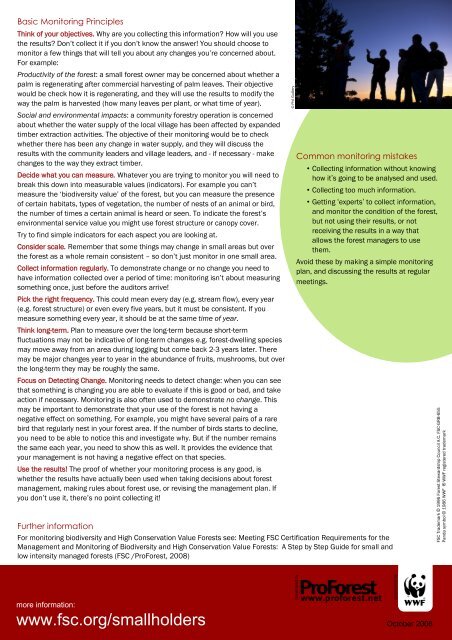Simple monitoring methods - FSC - Forest Stewardship Council
Simple monitoring methods - FSC - Forest Stewardship Council
Simple monitoring methods - FSC - Forest Stewardship Council
Create successful ePaper yourself
Turn your PDF publications into a flip-book with our unique Google optimized e-Paper software.
Basic Monitoring Principles<br />
Think of your objectives. Why are you collecting this information? How will you use<br />
the results? Don’t collect it if you don’t know the answer! You should choose to<br />
monitor a few things that will tell you about any changes you’re concerned about.<br />
For example:<br />
Productivity of the forest: a small forest owner may be concerned about whether a<br />
palm is regenerating after commercial harvesting of palm leaves. Their objective<br />
would be check how it is regenerating, and they will use the results to modify the<br />
way the palm is harvested (how many leaves per plant, or what time of year).<br />
Social and environmental impacts: a community forestry operation is concerned<br />
about whether the water supply of the local village has been affected by expanded<br />
timber extraction activities. The objective of their <strong>monitoring</strong> would be to check<br />
whether there has been any change in water supply, and they will discuss the<br />
results with the community leaders and village leaders, and - if necessary - make<br />
changes to the way they extract timber.<br />
Decide what you can measure. Whatever you are trying to monitor you will need to<br />
break this down into measurable values (indicators). For example you can’t<br />
measure the ‘biodiversity value’ of the forest, but you can measure the presence<br />
of certain habitats, types of vegetation, the number of nests of an animal or bird,<br />
the number of times a certain animal is heard or seen. To indicate the forest’s<br />
environmental service value you might use forest structure or canopy cover.<br />
Try to find simple indicators for each aspect you are looking at.<br />
Consider scale. Remember that some things may change in small areas but over<br />
the forest as a whole remain consistent – so don’t just monitor in one small area.<br />
Collect information regularly. To demonstrate change or no change you need to<br />
have information collected over a period of time: <strong>monitoring</strong> isn’t about measuring<br />
something once, just before the auditors arrive!<br />
Pick the right frequency. This could mean every day (e.g. stream flow), every year<br />
(e.g. forest structure) or even every five years, but it must be consistent. If you<br />
measure something every year, it should be at the same time of year.<br />
Think long-term. Plan to measure over the long-term because short-term<br />
fluctuations may not be indicative of long-term changes e.g. forest-dwelling species<br />
may move away from an area during logging but come back 2-3 years later. There<br />
may be major changes year to year in the abundance of fruits, mushrooms, but over<br />
the long-term they may be roughly the same.<br />
Focus on Detecting Change. Monitoring needs to detect change: when you can see<br />
that something is changing you are able to evaluate if this is good or bad, and take<br />
action if necessary. Monitoring is also often used to demonstrate no change. This<br />
may be important to demonstrate that your use of the forest is not having a<br />
negative effect on something. For example, you might have several pairs of a rare<br />
bird that regularly nest in your forest area. If the number of birds starts to decline,<br />
you need to be able to notice this and investigate why. But if the number remains<br />
the same each year, you need to show this as well. It provides the evidence that<br />
your management is not having a negative effect on that species.<br />
Use the results! The proof of whether your <strong>monitoring</strong> process is any good, is<br />
whether the results have actually been used when taking decisions about forest<br />
management, making rules about forest use, or revising the management plan. If<br />
you don’t use it, there’s no point collecting it!<br />
Common <strong>monitoring</strong> mistakes<br />
• Collecting information without knowing<br />
how it’s going to be analysed and used.<br />
• Collecting too much information.<br />
• Getting ‘experts’ to collect information,<br />
and monitor the condition of the forest,<br />
but not using their results, or not<br />
receiving the results in a way that<br />
allows the forest managers to use<br />
them.<br />
Avoid these by making a simple <strong>monitoring</strong><br />
plan, and discussing the results at regular<br />
meetings.<br />
Further information<br />
For <strong>monitoring</strong> biodiversity and High Conservation Value <strong>Forest</strong>s see: Meeting <strong>FSC</strong> Certification Requirements for the<br />
Management and Monitoring of Biodiversity and High Conservation Value <strong>Forest</strong>s: A Step by Step Guide for small and<br />
low intensity managed forests (<strong>FSC</strong> /Pro<strong>Forest</strong>, 2008)<br />
© Phil Guillery<br />
<strong>FSC</strong> Trademark © 1996 <strong>Forest</strong> <strong>Stewardship</strong> <strong>Council</strong> A.C. <strong>FSC</strong>-GRB-655<br />
Panda symbol © 1986 WWF ® WWF registered trademark<br />
more information:<br />
www.fsc.org/smallholders<br />
developed by<br />
sponsored by<br />
October 2008

















